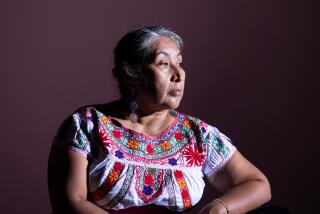Heart of a Nation : As chief of the Cherokees, Wilma Mankiller meshes traditional and modern Indian issues. The tribe’s strength, she says, lies in self-determination.
- Share via
When Wilma Mankiller talks about her job, she describes it as “something like running a big corporation and a little country at the same time.”
What she doesn’t say is that she is making history.
At 47, Mankiller straddles the worlds of mainstream baby boomers and rural American Indians--whose very survival has been her driving force since the 1960s.
It’s a balance she preaches to all American Indians. “Dual status is critical to our survival as a culturally distinct people,” she said.
As the first woman to lead a major North American tribe--she was elected principal chief of the 150,000-member Cherokee Nation in 1987--Mankiller has instigated an ambitious economic development program that many consider a model for grass-roots participation. (“ Chief has such a nice powerful sound,” she noted dryly, “but leadership here, like anywhere else, has to be done in a team way.”)
She also is credited with helping to raise mainstream awareness of historical and contemporary Indian issues. Her induction last month into the Seneca Falls National Women’s Hall of Fame was only the latest in a string of honorary degrees and awards.
Said her friend and admirer Gloria Steinem: “Her position as chief has much more responsibility than a U.S. senator. It’s a very large tribal government (second only to the Navajo Nation) and budget, which she has enlarged twentyfold.”
It was Steinem who persuaded Mankiller to write her autobiography. “Mankiller: A Chief and Her People” has just been published by St. Martin’s Press, and its author is preparing for a 15-city promotional tour, which will bring her to Los Angeles on Wednesday). She’ll sign books Wednesday night at 7:30 at thezMidnight Special Bookstore on Santa Monica’s Third Street Promenade.
Mankiller, said Steinem, who has known her since the mid ‘80s, is a contemporary leader who should be a household name but isn’t because she operates with so little fanfare. “For people familiar with community development or rural health care or women’s political issues, Wilma’s name brings enormous respect and affection and she is a touchstone,” Steinem said. “But in the world at large, she isn’t yet known. I hope this book will make the difference.”
Speaking by phone from her Oklahoma office last week, Mankiller discussed her work and her book, which she hopes will bridge the “woeful absence of accurate information about native people for most Americans. There has been such a void.”
That’s why she sandwiches public-speaking engagements between constant lobbying trips to Washington and a full administrative schedule at her office in the Cherokee capital of Tahlequah.
(Said Los Angeles acquaintance Frances Kidd: “When I first read an article about her, I thought she had to be 90 years old, she had accomplished so much.”)
She is a fifth-generation Mankiller, a distinguished Cherokee title similar to Major or Captain.
“Except for formal tribal things, most people call me Wilma,” she said in response to the inevitable question. “I would feel pretty silly walking around this little town being called Chief Mankiller.”
Her name still provokes occasional snide remarks. When she was invited last December to President-elect Bill Clinton’s historic economic summit meeting in Little Rock, the Wall Street Journal editorialized: “Our favorite name on the summit list . . . is Chief Wilma Mankiller, representing the Cherokee Nation, though we hope not a feminist economic priority.”
She brushed it off, noting that most people she meets, including members of the media, are more sensitive than that. As chief of the 14-county Cherokee Nation, Mankiller oversees an annual budget of $78 million, 1,200 full-time employees and an another 500 in peripheral businesses and agencies. “We are more of a republic than a reservation and exist in a complex set of laws in relationship to the U.S. government,” she said. “We view it as a dual citizenship.”
She broke with tradition in 1983 when she ran for deputy chief and discovered that women have as many problems in tribal politics as politics anywhere else. Cherokee Nation elections are held every four years for chief, deputy chief and a 15-member tribal council, and there have been few women candidates.
“The ’83 election was extremely hurtful,” she said. “There were so many people opposed to me because I’m a woman. These are big positions in our part of the world.
“I’m only in an elected position because that’s where you can allocate resources for things you believe in,” she added. “I’m an old ‘60s person--’think globally and act locally.’ ”
In 1991, however, she was reelected with 82% of the vote, which she sees as a mandate for her considerable work.
“We run Head Start programs, five primary health care clinics in five counties, a fully accredited high school and a Job Corps training center,” she said. “We provide lots and lots of social services and job trainings. We build houses, we build water systems, we provide several hundred thousand (dollars) in college scholarships.”
Her approach is self-determination: “We do better as a people when we can work on our own issues and concerns and problems.”
Bob Friedman, chairman of San Francisco’s Corporation for Enterprise Development, who has worked with Mankiller, describes her as a “prudent businesswoman with the tenacity of a bird dog.”
“She went into communities that had been written off--where people warned her not to go without a gun,” Friedman said. “She has re-instilled people’s sense of hope in themselves.”
Mankiller lives on Mankiller Flats, a 160-acre tract given to her grandfather by the federal government when Oklahoma became a state.
She lived there until the age of 11 when her family (her parents had 11 children) was forced by government relocation policy to move to San Francisco.
The move to the city from a farm that lacked electricity or running water was a nightmare. “Everything happened at once: I was going through puberty, I went to a school where I dressed differently and talked differently, and everybody laughed at my name.”
At one point her mother, trying to be helpful, gave her a home permanent. “It was awful,” she recalled.
“My mother had her hands full, living in a city with a lot of children,” she added. “I know it was hard for her.”
Still, the relocation experience shaped her life. Mankiller was married, the mother of two daughters and a “typical housewife” in 1969 when a group of Indians occupied Alcatraz Island as a political protest. It was a benchmark for Mankiller, who started studying sociology and working on treaty-rights and education issues. She returned to Oklahoma in 1974 to do development work.
Since 1986 she has been married to Charlie Soap, a Cherokee community developer and organizer who, she says, is not threatened by being married to the principal chief. “He’s a supportive and secure male,” she said. “We both have horrendous schedules and if something needs to be done, like taking clothes to the cleaner’s, he has no problem with it.”
Soap’s teen-age son, Winterhawk, lives with them in Mankiller’s comfortable book-filled house, surrounded by oaks, willows, hickory, dogwood and redbud trees that typify the Oklahoma hills. Her two daughters, Gina and Felicia, are both married, and Mankiller proudly displays pictures of four grandchildren.
When she decided to write her autobiography, she says, there was no question of its form: “I couldn’t separate myself from Cherokee history.”
With co-author Michael Wallis, she created a three-part form that interweaves her first-person narrative with Cherokee history, opening each chapter with a traditional Cherokee story:
“In the beginning, before Mother Earth was made, there was only a vast body of water that was both salty and fresh. There were no human beings, only animals. They lived in the heavens above the sea. . . .”
“For a lot of everyday Americans, it is hard to understand contemporary tribal issues without putting them into context,” she said. “It would have been useless for me to write about my life without including history.
“It is really hard for people who don’t know our history to understand that one of the most powerful countries in history had a policy of wiping us off the face of the Earth, then instituted a number of repressive policies to deal with the ‘Indian problem.’ ”
Despite a history of major upheavals, her vision for the Cherokee Nation is optimistic and forward-thinking.
“We’ve had many low points. The Trail of Tears has to stand out for tremendous loss of life and land, but there have been many others. We almost have to reinvent ourselves and our government again and again.
“But it amazes me how we’ve always managed to land on our feet.”
More to Read
Sign up for our Book Club newsletter
Get the latest news, events and more from the Los Angeles Times Book Club, and help us get L.A. reading and talking.
You may occasionally receive promotional content from the Los Angeles Times.






